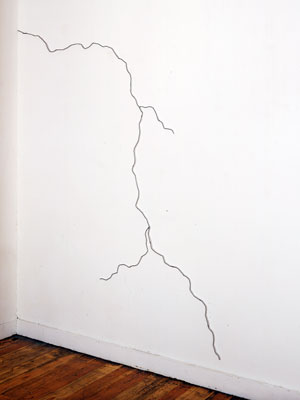The crack
 When he left home having reached eighteen years old, Oskar Serti settled into a garret next to that of the poet Virgil Bànek. Although he couldn’t distinctly hear the words of the poet from there, Serti was able, by applying his back against the panel which separated them, to feel resounding through his own body the verses that Virgil Bànek, leaning on the other side of the partition, recited each night in a gloomy voice.
When he left home having reached eighteen years old, Oskar Serti settled into a garret next to that of the poet Virgil Bànek. Although he couldn’t distinctly hear the words of the poet from there, Serti was able, by applying his back against the panel which separated them, to feel resounding through his own body the verses that Virgil Bànek, leaning on the other side of the partition, recited each night in a gloomy voice.
Having become a writer himself in 1902, Oskar Serti reminded himself of this episode and organized his very first public readings in apartments where he invited the guests to lean against the wall, before closing himself alone in an adjoining room. He would then start to mumble there his texts in a deep tone, consciously leaning on the other side of the partition which gathered his listeners who were supposed to vibrate at his speech.
Unfortunately, Serti’s approach was completely misunderstood and numerous parties even accused him of being singulary cowardly in face of the public and especially in face of his own texts.
In March 1955 after a long and brilliant exile, Serti returned to a homecoming covered with honour. During a highly visible visit to the walls of his first readings, Serti dallied in front of the deep cracks which had taken over. In front of an audience composed principally of those who had once criticized him so much, Serti superbly downplayed the role played by the famous November 1954 earthquake and, not without lyricism, justified the origin of these cracks by the fact that his texts had finally succeeded in penetrating the incomprehension in which they were for so long confined.
Opposite: reconstitution of the most remarkable cracks found on the apartments visited by Oskar Serti in 1902.